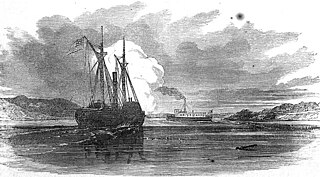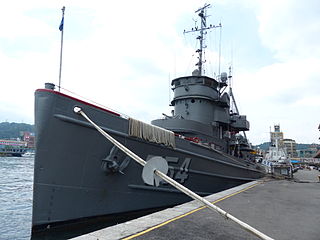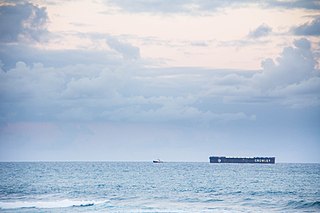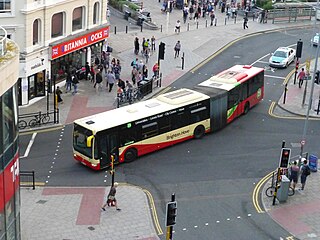
A tugboat or tug is a marine vessel that manoeuvres other vessels by pushing or pulling them, with direct contact or a tow line. These boats typically tug ships in circumstances where they cannot or should not move under their own power, such as in crowded harbour or narrow canals, or cannot move at all, such as barges, disabled ships, log rafts, or oil platforms. Some are ocean-going, some are icebreakers or salvage tugs. Early models were powered by steam engines, long ago superseded by diesel engines. Many have deluge gun water jets, which help in firefighting, especially in harbours.
ATB is the stagename of André Tanneberger,, a German DJ, musician, and producer of Trance music.

USS Achomawi (AT-148/ATF-148) was an Abnaki-class fleet ocean tugs in the service of the United States Navy, and was named for the Achomawi tribe of Native Americans.

Crowley, legally Crowley Maritime Corporation, is based in Jacksonville, Florida. Founded in 1892, Crowley is primarily a family- and employee-owned vessel management, owner, and supply chain logistics services company, providing services globally. As of July 2016, Crowley was ranked as the 13th largest private company in Florida, employing approximately 5,300 people worldwide with revenues of $2.2 billion. It provides its services using a fleet of more than 300 vessels, consisting of RO-RO vessels, LO-LO vessels, tankers, Articulated Tug-Barges (ATBs), tugs and barges. Crowley's land-based facilities and equipment include terminals, warehouses, tank farms, and specialized vehicles.

An articulated vehicle is a vehicle which has a permanent or semi-permanent pivot joint in its construction, allowing it to turn more sharply. There are many kinds, from heavy equipment to buses, trams and trains. Steam locomotives were sometimes articulated so driving wheels could pivot around corners.
USS Navajo (ATR-138/ATA-211) was an auxiliary ocean tug in the United States Navy.
USS Keosanqua (ATA-198) was a Maricopa-class auxiliary fleet tug of the United States Navy. The ship was authorized as Rescue Ocean Tug ATR-125, and redesignated Auxiliary Fleet Tug USS ATA-198 on 15 May 1944. The ship was laid down at Levingston Shipbuilding Co., Orange, Texas, launched on 17 January 1945, and commissioned on 19 March 1945. She was named Keosanqua (ATA-198) on 16 July 1948.
USS ATA-176 was an ATR-1-class rescue tug built for the United States Navy during World War II. She was laid down on 30 January 1944 and launched on 1 March as USS ATR-103, but was re-designated ATA-176 on 15 May. She was commissioned as USS ATA-176 on 19 August. She served in the U.S. Pacific Fleet during the war and was decommissioned on 30 June 1947. She was then manned with a civilian crew and placed in service, being renamed USNS Tonkawa (T-ATA-176) on 16 July 1948. Tonkawa, the first U.S. Navy vessel named for the Tonkawa, was taken out of service in 1956 and placed in reserve.

USS Wateree (ATF-117/AT-117) was an Abnaki-class fleet ocean tug acquired by the U.S. Navy during World War II. Wateree was sent to the western Pacific Ocean to perform towing services; however, during a typhoon, she was damaged beyond repair and lost, with eight crew members missing.

Thomas Hebert was an ocean-going tugboat that sank off the coast of New Jersey on Sunday 7 March 1993.
The second USS Undaunted was laid down as rescue tug ATR-126 on 27 November 1943 at Port Arthur, Texas, by the Gulfport Boiler and Welding Works; reclassified auxiliary ocean tug ATA-199 on 15 May 1944; launched on 22 August 1944; and commissioned on 20 October 1944.

The USS Pinola (ATA-206) was a Sotoyomo-class auxiliary fleet tug launched in 1945 and serving until 1956. The ship was transferred to the Republic of Korea in 1962.

USS Chimariko (ATF-154) was an Abnaki class Fleet Ocean Tug of the United States Navy and the first to be named Chimariko after the Native American tribe in California.

The SS St. Marys Challenger is a freight-carrying vessel operating on the North American Great Lakes built in 1906. Originally an ore boat, she spent most of her career as a cement carrier when much larger ore boats became common. After a 107-year-long working career as a self-propelled boat, she was converted into a barge and paired with the tug Prentiss Brown as an articulated tug-barge. Before conversion, she was the oldest operating self-propelled lake freighter on the Great Lakes, as well as being one of the last freight-carrying vessels on the Great Lakes to be powered by steam engines.

Seaforth Channel is a channel in the Central Coast region of the Canadian province of British Columbia which is part of the Inside Passage - the 950 miles (1,530 km) passage between Seattle, Washington and Juneau, Alaska. The marine highway goes through Seaforth Channel on the way to Milbanke Sound, one of the open sea portions of the Inland Passage. Seaforth Channel which is part of the Prince Rupert/Port Hardy BC ferry route, extends in a westerly direction from Denny Island to Milbanke Sound between Denny Island, Campbell Island and the Wright group of islands on the south. In October 2016, a Texas-owned tug/barge transiting the Canadian waters of the Inside Passage without a local pilot was hard grounded on a reef at the entrance to Seaforth Channel in October 2016. More than 100,000 L of fuel contaminated the coast, coves and shores 20 km (12 mi) west of Bella Bella, the core community of the Heiltsuk Nation as well as the environmentally sensitive Great Bear Rainforest - Canada's contribution to the Queen's Commonwealth Canopy (QCC), a network of forest conservation programs. Clean up response and salvage was criticized by the Heiltsuk, B.C. Premier Christy Clark and Prime Minister Justin Trudeau. In November in Vancouver the Prime Minister announced a $1.5B ocean protection plan to "create a marine safety system, restore marine ecosystems and undertake research into oil spill cleanup methods."

The Type V ship is a United States Maritime Commission (MARCOM) designation for World War II tugboats. Type V was used in World War II, Korean War, and the Vietnam War. Type V ships were used to move ships and barges. Type V tugboats were made of either steel or wood hulls. There were four types of tugboats ordered for World War II. The largest type V design was the sea worthy 186-foot (57 m) long steel hull, V4-M-A1. The V4-M-A1 design was used by a number of manufacturers; a total of 49 were built. A smaller steel hull tugboat was the 94-foot (29 m) V2-ME-A1; 26 were built. The largest wooden hull was the 148-foot (45 m) V3-S-AH2, of which 14 were built. The smaller wooden hull was the 58-foot (18 m) V2-M-AL1, which 35 were built. Most V2-M-AL1 tugboats were sent to the United Kingdom for the war efforts under the lend-lease act. The Type V tugs served across the globe during World War II including: Pacific War, European theatre, and in the United States. SS Farallon, and other Type V tugs, were used to help built Normandy ports, including Mulberry harbour, on D-Day, 6 June 1944, and made nine round trips to Normandy to deliver Phoenix breakwaters.

USS Paiute (ATF-159) was an Abnaki-class tug of the United States Navy during World War II, the Korean War, Vietnam War, and Persian Gulf War. She served a total of 44 years before being scrapped.

Samuel de Champlain is a large, twin-screw tugboat owned by Lafarge North America and managed by Andrie Inc. The vessel is paired with the cement barge Innovation, transporting cement products between Lafarge facilities across the Great Lakes.
Sea Machines Robotics is a Boston, MA-based startup that is developing autonomous control and navigation systems for the commercial marine and boating industries.
The SS J.L. Mauthe, was originally a straight-deck bulk carrier steamship, hull #298, built in 1952 by the Great Lakes Engineering Works on the River Rogue, Michigan site and delivered to its owner, Interlake Steamship Company. The SS J.L. Mauthe operated as a self-propelled vessel for 46 years. Upon conversion into a barge, it was renamed as Pathfinder and is currently active on the lakes as an articulated tug-barge unit, paired with the tug Dorothy Ann.













